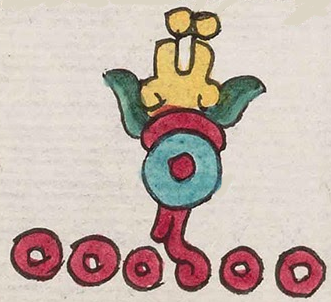Macuilxochic (Mdz44r)
This compound glyph for the place name Macuilxochic (or Macuilxochic-Cuauhquechollan, with the former being a subdivision of the latter), should be read from bottom to top, with the number five (macuilli) appearing at the bottom as five ones (red circles) with concentric circles (not colored). Reading upward from there we see a flower (xochitl) in beautiful red (possibly a root and another, central part of the flower), turquoise (a circular band at the base of the flower, perhaps the ovary, with a red-colored concentric circle, perhaps the ovule), yellow (perhaps the style, stigma, and two anthers), and green (perhaps sepals).
Stephanie Wood
The macuilxochitl, according to Frances Karttunen, is a marigold. But the name Macuilxochitl could refer to places and to deities. There is a town named Maculxochic in the state of Oaxaca, but this settlement of Macuilxochic was associated with Cuauhquechollan, modern Huaquechula, in the state of Puebla. Five Flower is a day sign in the calendar. It is also associated with a solar deity (or natural force), linked to Tonaleque. Macuilxochitl was also known as Xochipilli, linked to sensual pleasure, dancing, and music. It also has connections to a game of dice and therefore to gambling.
In some flowers, such as this one, the anthers are rather pronounced. The anthers are the flower parts that produce and provide the pollen which has the reproductive capacity that has been compared in Western cultures to semen.
Stephanie Wood
macuilxochic. puo
Macuilxochic, pueblo (San Mateo Macuilxochitl de Artigas Carranza)
Stephanie Wood
c. 1541, or by 1553 at the latest
Stephanie Wood
five, flowers, nombres de lugares

macuilxochi(tl), marigold, https://nahuatl.wired-humanities.org/content/macuilxochitl-0
macuil(li), five, https://nahuatl.wired-humanities.org/content/macuilli
xochi(tl), flower, https://nahuatl.wired-humanities.org/content/xochitl
-c (locative suffix), https://nahuatl.wired-humanities.org/content/c
"Marigold Place" [Frances Karttunen, unpublished manuscript, used here with her permission.]
"Place of the God Macuilxochitl" (Berdan and Anawalt, 1992, vol. 1, p. 190)
Codex Mendoza, folio 44 recto, https://digital.bodleian.ox.ac.uk/objects/2fea788e-2aa2-4f08-b6d9-648c00..., image 98 of 188.
The Bodleian Libraries, University of Oxford, hold the original manuscript, the MS. Arch. Selden. A. 1. This image is published here under the UK Creative Commons, “Attribution-NonCommercial-ShareAlike 3.0 License” (CC-BY-NC-SA 3.0).

